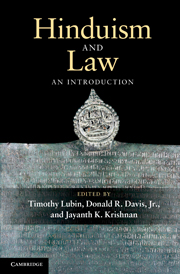Book contents
- Frontmatter
- Contents
- List of contributors
- Acknowledgements
- Chronology
- Abbreviations
- Map South Asia: political divisions c. 1860 and today
- Introduction
- Part I Hindu law
- Part II Law in ancient and medieval Hindu traditions
- Part III Law and modern Hinduism
- Chapter 12 Temples, deities, and the law
- Chapter 13 In the divine court of appeals
- Chapter 14 Contemporary caste discrimination and affirmative action
- Chapter 15 Law and Hindu nationalist movements
- Chapter 16 Legally and politically layered identities
- Glossary
- Bibliography
- Index
Chapter 14 - Contemporary caste discrimination and affirmative action
Published online by Cambridge University Press: 05 June 2012
- Frontmatter
- Contents
- List of contributors
- Acknowledgements
- Chronology
- Abbreviations
- Map South Asia: political divisions c. 1860 and today
- Introduction
- Part I Hindu law
- Part II Law in ancient and medieval Hindu traditions
- Part III Law and modern Hinduism
- Chapter 12 Temples, deities, and the law
- Chapter 13 In the divine court of appeals
- Chapter 14 Contemporary caste discrimination and affirmative action
- Chapter 15 Law and Hindu nationalist movements
- Chapter 16 Legally and politically layered identities
- Glossary
- Bibliography
- Index
Summary
In the spring of 2006, medical students at the elite All India Institute of Medical Sciences (AIIMS) in Delhi, dressed in their white coats, took up brooms and swept the streets. They were protesting against affirmative-action policies by suggesting that they would become untouchable “sweepers” if proposals to increase lower-caste student admissions were implemented. In 2007, the government-sponsored Thorat Committee report on the All India Institute of Medical Sciences documented continuing casteism, including denial of promotions to low-caste faculty, segregation of low-caste students in distinct hostels (dorms), and blatant harassment of low-caste students (Mitta 2007). In 2008, the Supreme Court of India upheld the expansion of affirmative action in higher education, noting the “duty of the State to promote positive measures to remove barriers of inequality and enable diverse communities to enjoy the freedoms and share the benefits guaranteed by the Constitution” (Ashoka Kumar Thakur v. Union of India and Others [2008], SCCL.COM 436).
Caste discrimination in India continues. Affirmative-action laws, known as “reservations” and based on caste and socioeconomic categories, are an important legal means to offset this discrimination. India’s affirmative-action policies are among the oldest and most far-reaching affirmative-action policies in the world, but the future of these policies is the subject of ongoing societal and legal controversy and debate. This chapter will introduce the problem of contemporary caste discrimination, the affirmative-action policies to combat it, and three contemporary developments: classification controversies, international activism, and growing attention to other disadvantages, in addition to caste, in Indian affirmative action.
- Type
- Chapter
- Information
- Hinduism and LawAn Introduction, pp. 215 - 233Publisher: Cambridge University PressPrint publication year: 2010



